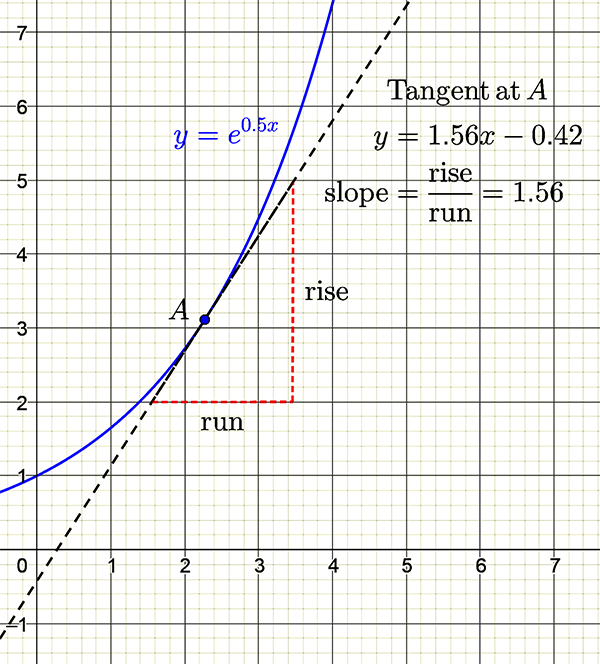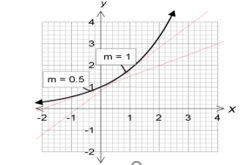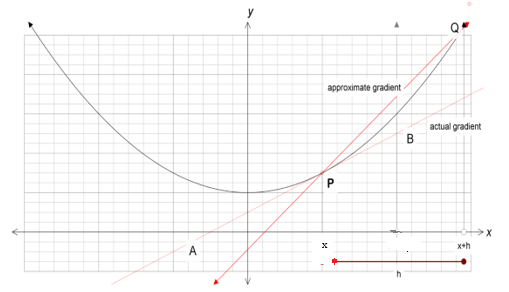D2 Gradients, tangents and derivatives

A tangent is a line that touches a curve at only one point. Where that point sits along the function curve, determines the slope (i.e. the gradient) of the tangent to that point.
A derivative of a function gives you the gradient of a tangent at a certain point on a curve. If you plug the x value into the derivative function, you will get the slope of the tangent at that point, defined by the x value. Practice evaluating the gradients of these tangents to a curve.
(See also Functions and graphs)
Gradient of a Curve
In this module we are concerned with finding a formula for the slope or gradient of the tangent at any point on a given curve \(y\)=\(f(x)\).

The formula \(m=\frac{y_{2}-y_{1}}{x_{2}-x_{1}}\) may be used to find the gradient of a line when two points on the line, \(\left(x_{1},y_{1}\right)\) and \(\left(x_{2},y_{2}\right)\) are known.1 There are two special cases that have to be dealt with: horizontal and vertical lines. A horizontal line parallel to the \(x\)-axis with equation of the form \(y=k\) where \(k\) is a constant, has a gradient of zero. As a line becomes closer to vertical its gradient gets larger. A vertical line parallel to the \(y\)-axis with equation of the form \(x=c\) where \(c\) is a constant has a gradient which is undefined.
Consider the gradient of the curve defined by \(y=f(x)\) at the point P (ie the gradient of the tangent line AB).

This gradient cannot be calculated as only one point (the point \(P\)) on the line is known. But the point \(P\) has coordinates \(\left(x,f(x)\right)\)and the point \(Q\) has coordinates \(\left(x+h,f(x+h)\right)\). The gradient of the line \(PQ\) can be calculated and this can be used to approximate the gradient of \(AB\). The gradient of \(PQ\) = \(\frac{f(x+h)-f(x)}{h}\). As the value of \(h\) decreases (i.e \(Q\) becomes closer to the point \(P\)), the approximation of the gradient is more accurate. The value of the gradient becomes most accurate as \(h\) approaches zero.
The gradient formula for the curve \(y=f(x)\) is defined as the derivative function
\[ f'(x)=\lim_{h\rightarrow0}\frac{f(x+h)-f(x)}{h},h\text{$\neq$ }0. \]
The derivative function\(f'(x)\) gives the slope of the tangent to the curve\(f(x)\) at any point x.
Example
The derivative of the function \(f(x)=\frac{3}{x}\) is \(f'(x)=-\frac{3}{x^{2}}\). Find the slope of the tangent to the curve at \(x=4\).
Solution
At \(x\) = 4, \[\begin{align*} f'(x) & =-\frac{3}{4^{2}}\\ & =-\frac{3}{16}. \end{align*}\] Hence the slope of the tangent at \(x=4\) is \(-\frac{3}{16}\,.\)
Exercises
- If the derivative function for \(f(x)=x^{3}-x\) is \(f'(x)=3x^{2}-1\), find the slope of the tangent to this curve at
\(\quad\text{a) }x=2\quad\text{b) $x=0\quad\text{c) $x=-9$ .}$ }\)
- If the derivative function of \(f(x)=\sin\left(x\right)\) is \(f'(x)=\cos\left(x\right)\) find the gradient of \(f(x)=\sin\left(x\right)\) at
\(\quad\text{a) }x=0\quad\text{b) $x=\pi/2\quad\text{c) $x=3.5\,$ .}$ }\)
- Determine \(\lim_{h\rightarrow0}\frac{(x+h)^{2}-x^{2}}{h}\) and hence find the slope of the tangent to the curve \(y=x^{2}\) at
\(\quad\text{a) }x=2\quad\text{b) $x=0\quad\text{c) $x=-9\,$ .}$ }\)
\(\quad\text{a) }4\quad\text{b) $x=0\quad\text{c) $-18\,$ .}$ }\)
Download this page, D2 Gradients, tangents and derivatives (PDF 273KB)
What's next... D3 Differentiation from first principles
